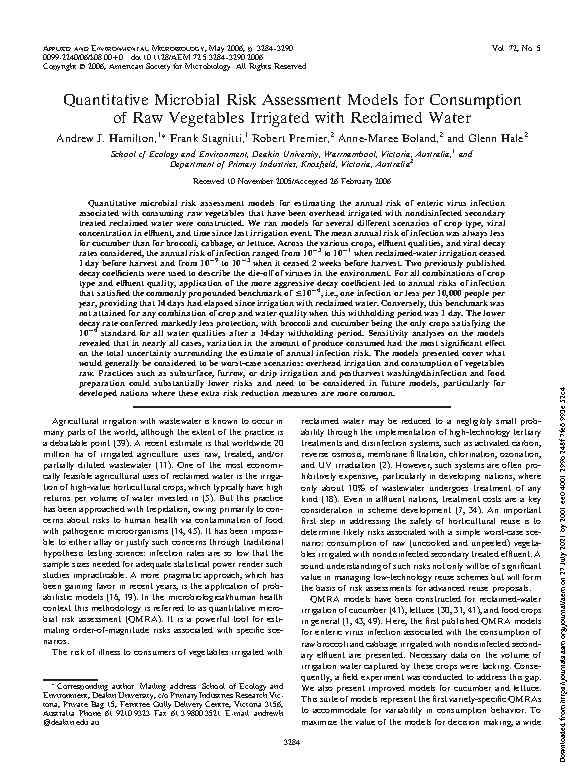Article Quantitative Microbial Risk Assessment Models for Consumption of Raw Vegetables Irrigated with Reclaimed Water
26/08/2024
DOCUMENT DESCRIPTION
Quantitative microbial risk assessment models for estimating the annual risk of enteric virus infection associated with consuming raw vegetables that have been overhead irrigated with nondisinfected secondary treated reclaimed water were constructed. We ran models for several different scenarios of crop type, viral concentration in effluent, and time since the last irrigation event.
The mean annual risk of infection was always less for cucumber than for broccoli, cabbage, or lettuce. Across the various crops, effluent qualities, and viral decay rates considered, the annual risk of infection ranged from 10⁻³ to 10⁻¹ when reclaimed-water irrigation ceased 1 day before harvest, and from 10⁻⁹ to 10⁻³ when it ceased 2 weeks before harvest.
Two previously published decay coefficients were used to describe the die-off of viruses in the environment. For all combinations of crop type and effluent quality, application of the more aggressive decay coefficient led to annual risks of infection that satisfied the commonly propounded benchmark of <10⁻⁴, i.e., one infection or less per 10,000 people per year, provided that 14 days had elapsed since irrigation with reclaimed water. Conversely, this benchmark was not attained for any combination of crop and water quality when this withholding period was 1 day.
The lower decay rate conferred markedly less protection, with broccoli and cucumber being the only crops satisfying the 10⁻⁴ standard for all water qualities after a 14-day withholding period. Sensitivity analyses on the models revealed that in nearly all cases, variation in the amount of produce consumed had the most significant effect on the total uncertainty surrounding the estimate of annual infection risk.
The models presented cover what would generally be considered to be worst-case scenarios: overhead irrigation and consumption of vegetables raw. Practices such as subsurface, furrow, or drip irrigation, and post-harvest washing/disinfection and food preparation could substantially lower risks and need to be considered in future models, particularly for developed nations where these extra risk reduction measures are more common.


